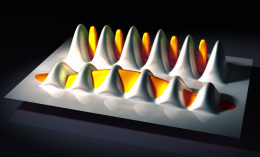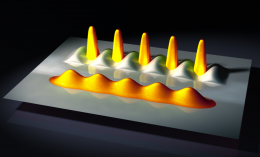Pinning atoms into order

In an international first, physicists of the University of Innsbruck, Austria have experimentally observed a quantum phenomenon, where an arbitrarily weak perturbation causes atoms to build an organized structure from an initially unorganized one. The scientific team headed by Hanns-Christoph Nagerl has published a paper about quantum phase transitions in a one dimensional quantum lattice in the scientific journal Nature.
With a Bose-Einstein condensate of cesium atoms, scientists at the Institute for Experimental ��������ics of the University of Innsbruck have created one dimensional structures in an optical lattice of laser light. In these quantum lattices or wires the single atoms are aligned next to each other with laser light preventing them from breaking ranks. Delete using an external magnetic field allows the physicists to tune the interaction between the atoms with high precision and this set-up provides an ideal laboratory system for the investigation of basic physical phenomena. “Interaction effects are much more dramatic in low-dimensional systems than in three dimensional space,“ explains Hanns-Christoph Nagerl. Thus, these structures are of high interest for physicists. It is difficult to study quantum wires in condensed matter, whereas ultracold quantum gases provide a versatile tunable laboratory system. And these favorable experimental conditions open up new avenues to investigate novel fundamental phenomena in solid-state or condensed matter physics such as quantum phase transitions.
Quantum phase transition

The Innsbruck physicists have observed a “pinning transition“ from a superfluid (“Luttinger liquid“) to an insulated phase (“Mott-insulator“). In their experiment they showed that for strongly interacting atoms an additional weak lattice potential was sufficient to pin the atoms to fixed positions along the wire (“pinning”). The atoms were cooled down to nearly absolute zero and were in their quantum mechanical ground state. “It is not thermal fluctuations that induce the phase transition,“ stresses PhD student Elmar Haller, who is also first author of the study, which has been published in the journal Nature. “In fact, the atoms are already correlated due to strong repulsive interaction and only need a small push to align regularly along the optical lattice,“ explains Haller. When the lattice is removed, the atoms return to a superfluid state.
Theoretical prediction
The phenomenon observed by the experimental physicists was proposed by three theorists two years ago, two of whom - Wilhelm Zwerger and Hans Peter Büchler - also worked at the University of Innsbruck. With theorists and experimental physicists cooperating closely and a big pool of highly qualified scientists, the internationally renowned research centre for physics in Innsbruck offers an excellent framework for the experimental physicists of the research group headed by Wittgenstein awardee Rudolf Grimm to pursue basic research in physics.
More information: Pinning quantum phase transition for a Luttinger liquid of strongly interacting bosons. Elmar Haller, Russell Hart, Manfred J. Mark, Johann G. Danzl, Lukas Reichsöllner, Mattias Gustavsson, Marcello Dalmonte, Guido Pupillo, and Hanns-Christoph Nägerl. Nature 29 July 2010.
Provided by University of Innsbruck




















